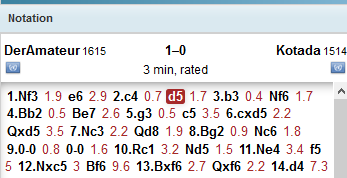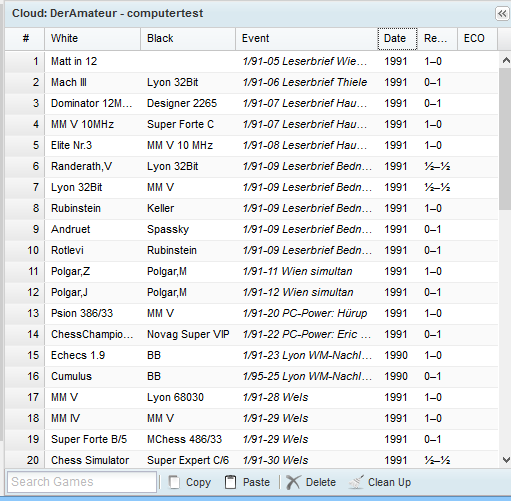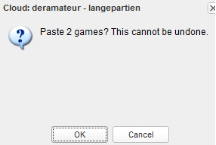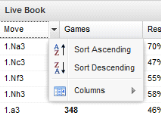|
User Interface |

|

|
|
|
User Interface |

|

|
User Interface
The user interface is well structured. At the top of the screen the application's functions are listed.

Apart from this there is a board window, a notation window, the game list and direct access to the Live Book, which contains embedded statistical information.

The windows can be resized using the small arrows in the separators.
On the graphic chess board in the board window you can either enter moves or replay games that you have loaded from databases.
You can configure the board window by picking a different chess set in the Boards menu.
The game list of the selected database and the statistical information about the board position are also displayed. The Live Book is described below.
Other important functions, such as taking a move back, flipping the board or loading a chess engine are available at the top of the screen.
Notations window
The notation window contains the moves in the current game and any available commentary.

Clicking on a move in the notation loads that board position. There is a toolbar below the notation window with functions to edit the notation.

| • | Text Before - This adds a text in the notation before the selected move. You can enter the text in the input field at the bottom of the screen. |
| • | Text After - This adds a text in the notation after the selected move. |
| • | Start Line - This takes back the selected move and begins the input of a variation. |
| • | Promote Line - This makes the selected variation the main line. |
| • | Delete Line - This deletes the selected variation. |
| • | Cut Line - This removes all the notation after the selected move. |
| • | Commentary Symbols - Chess games are often commented with standard international symbols. |
These symbols can be added to any move in the game's notation.
Game List
The game list contains a list of the games stored in the database.

The window's title bar tells you what database you are using.

The following functions are available for working with the games list.
Copy/Paste: Select an element in the list by clicking on it. Copy copies the game into the clipboard. If you open another database you can insert the game into it by clicking Paste.

Delete/Clean Up: Delete marks a game in the games list as deleted, but it has not yet been removed from the database. Clean Up removes games that have been marked as deleted from the database. If you want to restore a deleted game to the database, select it and click Delete again. This is no longer possible after using Clean Up.
![]()
The imput field below the games list can be used to carry out searches in the database, for instance searching for all games by a particular player.

The program immediately lists all games in which the search data is found.
Book Window
The program also displays the Live Book in a window.

This is an enormous openings tree that is based on the analyses of the Let's Check server. All the openings positions of the online database are contained, which makes the Live Book the most comprehensive and up to date source for openings theory. It is possible to play against it, or simply use it to look up a variation.
The Live Book is live, because it continually changes from second to second. Every position which is analysed by Let's Check is immediately entered into the Live Book! This means that if a top level game is being played on the server and there are kibitzers using Let's Check, as soon as the game is over deep engine analysis with evaluations is available in the Live Book for all the moves in the game.
You can use the Live Book to get an impression of the quality of a continuation, which is a valuable aid when replaying games.
If you click on a move in the Live Book, the move is made on the chess board.
Tip: When entering moves in a game you can save yourself many mouse clicks if you enter the opening moves with the help of the Live Book. Clicking on "New Game" opens an empty board window for entering moves. Clicking on the moves displayed in the Live Book transfers the moves into the board window.
It is also possible to enter variations. Go back to the position where a variation should start and make a different move on the chess board. There is no variation dialogue. The new moves are immediately entered into the notation as a variation.
The information about the current board position is divided into columns.
| • | Move: This shows all the possible moves in the position. |
| • | Games: This shows the number of games in which each move was played. |
| • | Result: This shows the success rate for each move from White's perspective. |
| • | Elo Avg: This shows the avarage Elo rating of the players in which each move was made. |
| • | [ % ]: This shows the number of games in which each move was made as a percentage. |
| • | Visits: This shows the number of times visitors have looked at the position resulting from each move. |
Sorting by columns
When a list is opened, for instance the games list or the Live Book, all the information is divided into lists.
Clicking on a column header sorts the list by the data in this column. Clicking a second time reverses the order.
Example: Clicking on White in the games list sorts the games in alphabetical order. Clicking a second time sorts the games in reverse alphabetical order. Clicking on Games in the Live Book sorts the list by the most commonly played moves. Clicking a second time sorts the list so that the least commonly played moves are first.
If you move over a column header a small black arrow is displayed.

Clicking on this arrow opens a drop down menu with which you can sort the data by the column or hide and display columns.